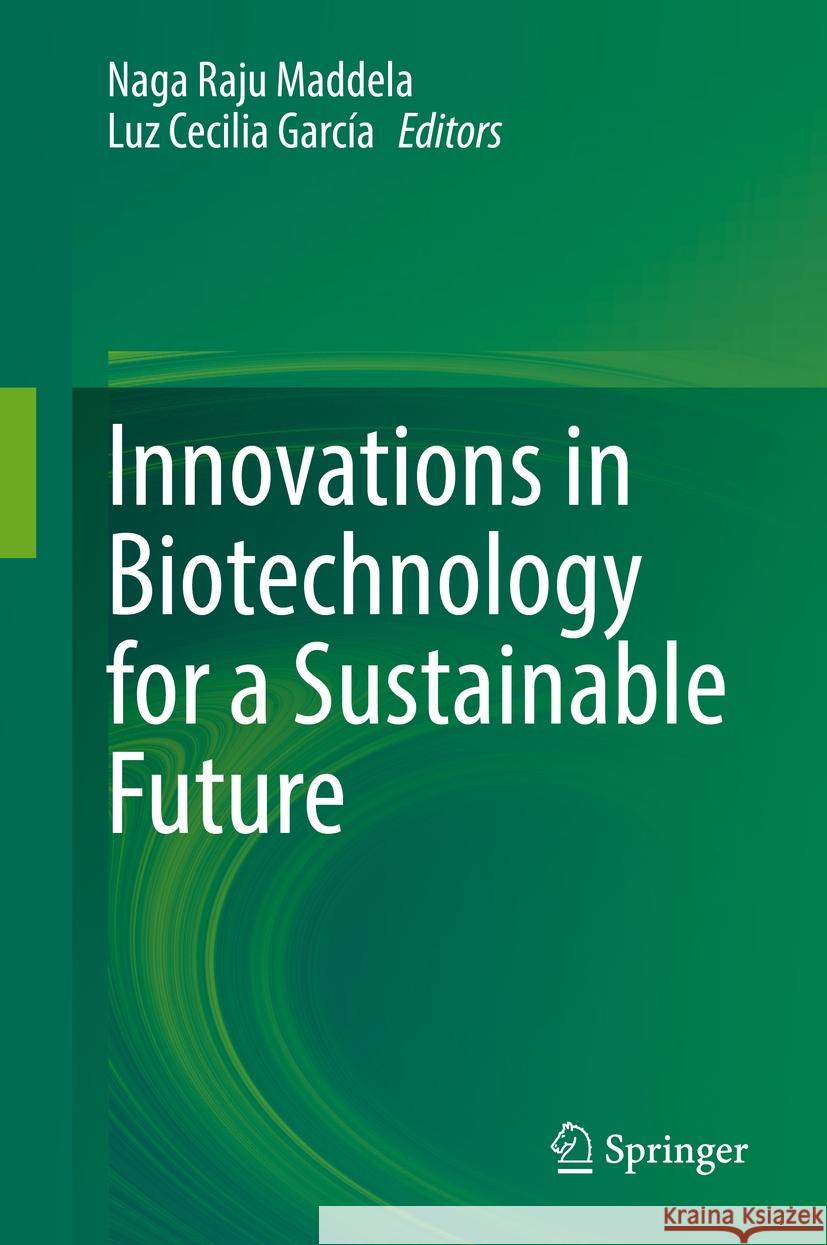Innovations in Biotechnology for a Sustainable Future » książka



Innovations in Biotechnology for a Sustainable Future
ISBN-13: 9783030801076 / Angielski / Twarda / 2021 / 502 str.
Innovations in Biotechnology for a Sustainable Future
ISBN-13: 9783030801076 / Angielski / Twarda / 2021 / 502 str.
(netto: 768,56 VAT: 5%)
Najniższa cena z 30 dni: 771,08
ok. 22 dni roboczych
Bez gwarancji dostawy przed świętami
Darmowa dostawa!
Part I: Biotechnology Overview
1. Introduction
Naga Raju Maddela*, Luz Cecilia García
2. Biotechnology of 21st Century
Aline Siteneski, Gilberto Vizkino
Part II: Industrial Biotechnology
3. Considerations on the Scaling of biological and chemical reactors
Rodriguez Rico Ivan Leandro
4. Design of a cultivation media for the production of metabolites with practical application in the biodegradation of industrial dyes
Daza Lopez Erlinjka Valentina*, Rosero Delgado Ernesto Alonso, Vera Bravo Peter Leonel
5. Obtaining and characterizing new biomaterials based on starch, for use in the food and health industry
López Terán Jorge Luis*, Maribel Beltrán, Juan Carlos Soriano, Elvia Cabrera
6. Influence of immersion time in pitahaya (Hylocereus undatus) proteolytic enzyme solutions on the texture of bovine meat
Zambrano Flores Freddy Miguel*, Pazmiño Castro Anderson Javier, Zambrano Flores Freddy Miguel
7. Determination of free amino acids in fermented and toasted cocoa (Theobroma cacao) samples, using high performance liquid chromatography with UV detection by diode arrangement
Brunetto de Gallignani Maria del Rosario*, Gallignani Máximo, Orozco Wendy, Delgado Yelitza
8. Characterization of cassava and bee wax residues for their use in the obtaining of bioplastic
Briones Muñoz Joselin Sofia*, Riera María Antonieta
9. Development of a thermoplastic material from the residues of the banana (Musa paradisiaca)
Maura Gabriela Alcívar Gavilanes*, Katiuska Lisette Carrillo Anchundia, María Antonieta Riera
Part III: Agricultural Biotechnology
10. Chemical ecology and its role in the conservation of threatened species: a case study in the Galapagos islands
Alejandro E. Mieles García
11. Energy evaluation of solid biofuels made from mixtures of lignocellulosic biomass
Palacios Bravo Holger Eugenio*, Beltrón Vinces Irene, Rosero Delgado Ernesto
12. Reforestation and conservation of vegetable germ plasm: challenges and expectations
Georgina Vargas Simón, División Académica de Ciencias Biológicas
13. Characterization of Moniliophthora roreri evans and evaluation of biological control alternatives in cacao (Theobroma cacao), for the Ecuadorian amazon
Carina Carrera Sanchez Carina María
14. Application of biotechnology to the search and selection of PGPR in the control of phytosanitary problems in cocoa (Theobroma cacao) and banana (Musa acuminata)
Canchignia Martines Ahyron Fabrico
15. Sustainability of organic quinoa cultivation (Chenopodium quinoa) in communities of colta Ecuador.
Julio Cesar Vargas, Alexandra Torres
16. Effects of artificial light intensity and temperature on the growth of lettuce (Lactuca sativa l.) in a vertical urban farm in low cost indoor
M. C. Daniel Fuentes Morales
17. Efficiency of led lights in the propagation and field of summer flowers in Ecuador
Elizabeth Ruth Urbano Salazar
Part IV: Environmental Biotechnology
18. Evaluation of extraction methods to obtain a natural flocculant from the tamarind seed (Tamarindus indica)
Sanchez Mendoza Virginia Annabelt*, Loor Moreira Caroline, Lucas Mendoza Ariana, Moreira Mendoza Carlos
19. Bicomponent adsorption of Brilliant blue FCF and tartrazine under dynamic conditions using rice husk
Fernández Andrade Kevin Jhon*, Gonzalez Vargas María Cristina.
20. Kinetic approach to the biocoagulation process of mixtures of Moringa oleífera and Caesalpinia spinosa in synthetic turby water.
Caroline Lissette Loor Moreira
21. Sustainable alternatives in the treatment of liquid industrial waste
Gilberto Colina A
22. Biodegradation of industrial dyes with enzymatic extracts obtained in FES and FEL systems with Pleurotus djamor
Wittong Zambrano Cindy Yaritza*, Montalvo Villaprado Lissette Dayanara, Rosero Delgado Ernesto Alonso
23. Removal of petroleum hydrocarbons from medium and soil (lab & field conditions) by microorganisms isolated from the Ecuadorian amazon rainforest
Naga Raju Maddela
Part V: Medicinal Plant Biotechnology
24. Chemistry of natural products
Elvia Victoria Cabrera
25. Evaluation of the antimicrobial activity of natural extracts of altamisa (Ambrosia artemisiifolia) and melissa (Melissa officinallis) for the control of pathogenic agents
Baque Suarez Rosa Franshesca*, Cadena Marcillo Lisbeth Stefanía, Sánchez Mendoza Virginia Annabelt, Jadán Piedra Carlos
26. Phenolic compounds of cocoa (Theobroma cacao) shell extraction and antimicrobial activity
Stalin Santacruz
27. Susceptibility to antimicrobials in strains of environmental origin, a public health problem
Montiel Romero Marynes
28. Inhibition effect of oregano (Origanum vulgare) essential oil on an active biodegradable film
Pazmiño Castro Anderson Javier*, Campuzano Vera Ana María, Marín Morocho Karina Marisabel
29. Current Challenges and Future Prospective of Biotechnology
Naga Raju Maddela, Luz Cecilia García
Dr. Naga Raju Maddela is a Professor in the Facultad de Ciencias de la Salud at the Universidad Técnica de Manabí, in Portoviejo, Ecuador.
Dr. Luz Cecilia García is a Director at the Instituto de Investigación & Professor in the Facultad de Ingeniería Agronómica at the Universidad Técnica de Manabí, in Portoviejo, Ecuador.
This contributed volume compiles the latest improvements in the field of biotechnology. It focuses on topics that comprises industrial, environment, agricultural and medical related issues to technology and biological studies and exhibits the correlation between the biological world and the dependence of humans on it. The book is organized into five parts covering the role of biotechnology in industrial products, environmental remediation, agriculture and pharmacological agents. Ranging from micro-scale studies to macro, it covers a huge domain of agricultural biotechnology and focuses on important commercial crops (e.g. cacao and coffee), arbuscular mycorrhizal fungi, flow and distribution of phosphorus in agricultural soils in the Latin American region. Overall, the book portrays the importance of modern biotechnology and its role in solving the problems in modern day life. The book is a ready reference for practicing students, researchers of environmental engineering, chemical engineering, agricultural engineering, and other allied fields likewise.
1997-2025 DolnySlask.com Agencja Internetowa
KrainaKsiazek.PL - Księgarnia Internetowa









